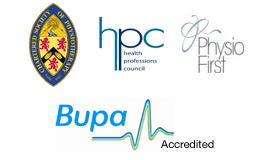Treatment modalities - how we help you...
Mobilisation: Mobilisation of the spinal or peripheral joints to decrease their stiffness and pain.
Manipulation: This is a high-velocity thrust technique. A sharp short movement is applied in order to push the joint slightly further then its usual movement in order to free it. This may be accompanied by a cracking sound. This is done to reduce pain, increase motion and to help the alignment of the spine. Peripheral joints can also be manipulated, but is more commonly done to the spine.
Soft tissue manipulation/massage: This is the technique to mobilise the soft tissue surrounding the muscle and bone in order to reduce rigidity, pain and increase range of motion.
Nerve mobilization: These are techniques to free restricted of movement along the path of the nerve, in order to restore the function of the nerve and surrounding tissue.
Muscle energy techniques: With these techniques we activate the affected muscle. After contraction the muscle will relax better and will stretch better without with less resistance.
Motion analysis software: This is an advanced video technology software system which helps the patients understand their motion and posture and subsequently correct it.
Ultrasound: This is a sound wave ( inaudible to the human ear), which promotes healing and reduces swelling and pain by increasing the blood circulation in the treated area. It can also be used to soften up scar tissue.
Interferential: This is a high frequency carrier waveform which relieves pain. Patients that react well to interferential often respond well to TENS machines which can be used to continue treatment at home and are low in cost to run.
EMG: Measures muscle contraction and can be used for evaluation and training of the affected muscle. It can be used with a wide variety of musculoskeletal problems, and often used with training for incontinence problems.
Spinal traction: This is a treatment where a longitudinal force is applied to the spine and as a result the spine is pulled in opposite directions. This is used in order to relieve pressure on certain components of the spine and decrease pain.
Trigger pointing: This is a technique where pressure is given at specific points in the muscle, often where there are taut bands of muscle fibers in order to release tension and increase blood flow.
Laser: Low level laser treatment is used to increase the blood circulation and stimulate cell growth in soft tissue and is used in painful musculoskeletal disorders.
Exercise regimes: These are given to the patient to improve their mobility and strength also to reduce pain and improve posture. This can include Pilates to improve the core stability around the spine and abdomen.





